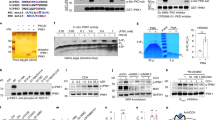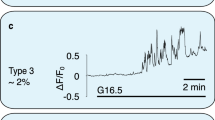Abstract
MANY hormones, neurotransmitters and growth factors evoke in their target cells oscillations in the free internal Ca2+ concentration ([Ca2+]i) (ref. 1). In electrically non-excitable cells these fluctuations are due to periodic release of Ca2+ from intracellular reservoirs1,2, stimulated by the internal messenger inositol trisphosphate (InsP3) (refs 2–4). Most models at present invoke fluctuating levels of InsP3 as a key component in generating the oscillations in [Ca2+]i (refs 5 and 6). InsP3 injected into intact cells evokes irregular and transient oscillatory Ca2+-dependent current responses7–9, but the intracellular InsP3 concentration is not constant in such experiments. Here we monitor changes in [Ca2+i by measuring Ca2+-activated Cl- current in single internally perfused mouse pancreatic acinar cells4,10–12and show that acetylcholine (ACh), acting through muscarinic receptors, evokes regular and repetitive current pulses which are mimicked by InsP3 applied through a patch pipette13. To exclude the possibility that InsP3is periodically phosphorylated14 or degraded, we replaced it by the non-metabolizable InsP3 analogue inositol trisphosphorothioate (InsPS3)9,15,16, which also evokes regular pulses of Ca2+-activated Cl- current. These effects are independent of external Ca2+, but abolished by high intracellular concentrations of a Ca2+-chelator. We conclude that repetitive pulses of intracellular Ca2+release occur even when the concentration of InsP3 is constant.
This is a preview of subscription content, access via your institution
Access options
Subscribe to this journal
Receive 51 print issues and online access
$199.00 per year
only $3.90 per issue
Buy this article
- Purchase on Springer Link
- Instant access to full article PDF
Prices may be subject to local taxes which are calculated during checkout
Similar content being viewed by others
References
Berridge, M. J. & Galione, A. FASEB J. 2, 3074–3082 (1988).
Berridge, M. J. Proc. R. Soc. 234, 359–378 (1988).
Streb, H., Irvine, R. F., Berridge, M. J. & Schulz, I. Nature 306, 67–69 (1983).
Oron, Y., Dascal, N., Nadler, E. & Lupu, M. Nature 313, 141–143 (1985).
Meyer, T. & Stryer, L. Proc. natn. Acad. Sci. U.S.A. 85, 5051–5055 (1988).
Rink, T. J. & Jacob, R. Trends Neurosci. 12, 43–46 (1989).
Payne, R., Walz, B., Levy, S. & Fein, A. Phil. Trans. R. Soc. 320, 359–379 (1988).
Berridge, M. J. J. Physiol. 403, 589–599 (1988).
Taylor, C. W., Berridge, M. J., Brown, K. D., Cooke, A. M. & Potter, B. V. L. Biochem. biophys. Res. Comm. 150, 626–632 (1988).
Petersen, O. H. & Philpott, H. G. J. Physiol. 306, 481–492 (1980).
Petersen, O. H. & Findlay, I. Physiol. Rev. 67, 1054–1116 (1987).
Randriamampita, C., Chanson, M. & Trautmann, A. Pflugers Arch. 411, 53–57 (1988).
Hamill, O. P., Marty, A., Neher, E., Sakmann, B. & Sigworth, F. J. Pflugers Arch. 391, 85–100 (1981).
Biden, T. J. & Wollheim, C. B. J. biol. Chem. 261, 11931–11934 (1986).
Cooke, A. M., Gigg, R. & Potter, B. V. L. J. chem. Soc., Chem. Comm. 1525–1526 (1987).
Taylor, C. W., Berridge, M. J., Cooke, A. M. & Potter, B. V. L. Biochem. J. 259, 645–650 (1989).
Yule, D. I. & Gallacher, D. V. FEBS Lett. 239, 358–362 (1988).
Gray, P. T. A. J. Physiol. 406, 35–53 (1988).
Woods, N. M., Cuthbertson, K. S. R. & Cobbold, P. H. Nature 319, 600–602 (1986).
Jaconi, M. E. E., Rivest, R. W., Schlegel, W., Wollheim, C. B., Pittet, D. & Lew, P. D. J. biol. Chem. 263, 10557–10560 (1988).
Evans, M. G. & Marty, A. Proc. natn. Acad. Sci. U.S.A. 83, 4099–4103 (1986).
Petersen, O. H. & Maruyama, Y. Nature 307, 693–696 (1984).
Suzuki, K. & Petersen, O. H. Am. J. Physiol. 255, G275–G285 (1988).
Strupish, J., Cooke, A.M., Potter, B. V. L., Gigg, R. & Nahorski, S. R. Biochem. J. 253, 901–905 (1988).
Willcocks, A. L., Potter, B. V. L., Cooke, A. M. & Nahorski, S. R. Eur. J. Pharmacol. 165, 181–183 (1988).
Cooke, A. M., Nahorski, S. R. & Potter, B. V. L. FEBS Lett. 242, 373–377 (1989).
Capiod, T., Field, A. C., Ogden, D. C. & Sandford, C. A. FEBS Lett. 217, 247–252 (1987).
Morris, A. P., Gallacher, D. V., Irvine, R. F. & Petersen, O. H. Nature 330, 653–655 (1987).
Changya, L., Gallacher, D. V., Irvine, R. F., Potter, B. V. L. & Petersen, O. H. J. Membrane Biol. 109, 85–93 (1989).
Thevenod, F., Dehlinger-Kremer, M., Kemmer, T. P., Christian, A.-L., Potter, B. V. L. & Schulz, I. J. Membrane Biol. (in the press).
Author information
Authors and Affiliations
Rights and permissions
About this article
Cite this article
Wakui, M., Potter, B. & Petersen, O. Pulsatile intracellular calcium release does not depend on fluctuations in inositol trisphosphate concentration. Nature 339, 317–320 (1989). https://doi.org/10.1038/339317a0
Received:
Accepted:
Issue Date:
DOI: https://doi.org/10.1038/339317a0
This article is cited by
-
Fast and synchronized fluctuations of cortical actin negatively correlate with nucleoli liquid–liquid phase separation in T cells
European Biophysics Journal (2020)
-
Cannabinoid receptor subtype 2 (CB2R) agonist, GW405833 reduces agonist-induced Ca2+ oscillations in mouse pancreatic acinar cells
Scientific Reports (2016)
-
Octanoate increases cytosolic Ca2+ concentration and membrane conductance in ovine pancreatic acinar cells
Journal of Comparative Physiology B (1996)
-
The role of magnesium in regulating CCK-8-evoked secretory responses in the exocrine rat pancreas
Molecular and Cellular Biochemistry (1996)
Comments
By submitting a comment you agree to abide by our Terms and Community Guidelines. If you find something abusive or that does not comply with our terms or guidelines please flag it as inappropriate.



